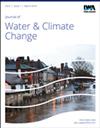Accounting for climate change in the water infrastructure design: evaluating approaches and recommending a hybrid framework
IF 3.1
4区 环境科学与生态学
Q2 WATER RESOURCES
引用次数: 0
Abstract
A traditional hydrologic water infrastructure design assumes that the climate is stationary, and that historic data reflect future conditions. The traditional approach may no longer be applicable since the earth's climate is not stationary. Thus, there is a need for a new way of designing water infrastructure that accounts for the effects of climate change by shifting the current static design paradigm to a more dynamic paradigm. Researchers have proposed several approaches accounting for climate change. In this paper, we group the approaches into five groups (adaptive management, inverse climate change impact, machine learning, flood frequency analysis, and soft computing approaches), outline each approach's strengths and weaknesses, and assess their applicability to the water infrastructure design. We find that the flood frequency analysis approach is most applicable to the water infrastructure design as it is the least disruptive in terms of standard hydrological analysis methods, is cost-effective, and adaptable to most basins. However, adaptive management approaches are best suited for uncertainty reductions since they provide opportunities to constantly adjust decisions based on improved climate change data. Combining these two approaches could provide an optimal way of accounting for non-stationarity.在水利基础设施设计中考虑气候变化因素:评估各种方法并提出混合框架建议
传统的水文水资源基础设施设计假定气候是静止的,历史数据反映了未来的状况。由于地球气候并非静止不变,传统方法可能不再适用。因此,需要一种新的水利基础设施设计方法,通过将当前的静态设计范式转变为更加动态的范式来考虑气候变化的影响。研究人员提出了几种考虑气候变化的方法。在本文中,我们将这些方法分为五组(适应性管理、逆气候变化影响、机器学习、洪水频率分析和软计算方法),概述了每种方法的优缺点,并评估了它们在水利基础设施设计中的适用性。我们发现,洪水频率分析方法最适用于水利基础设施设计,因为这种方法对标准水文分析方法的破坏性最小,成本效益高,而且适用于大多数流域。然而,适应性管理方法最适合用于减少不确定性,因为这种方法提供了根据改进的气候变化数据不断调整决策的机会。将这两种方法结合起来,可以提供一种考虑非稳定性的最佳方法。
本文章由计算机程序翻译,如有差异,请以英文原文为准。
求助全文
约1分钟内获得全文
求助全文
来源期刊

Journal of Water and Climate Change
WATER RESOURCES-
CiteScore
4.80
自引率
10.70%
发文量
168
审稿时长
>12 weeks
期刊介绍:
Journal of Water and Climate Change publishes refereed research and practitioner papers on all aspects of water science, technology, management and innovation in response to climate change, with emphasis on reduction of energy usage.
 求助内容:
求助内容: 应助结果提醒方式:
应助结果提醒方式:


